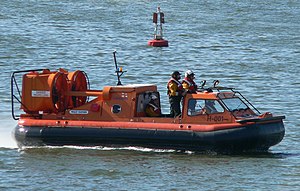H-class lifeboat
 RNLI Hovercraft H001 Molly Rayner in 2005
| |
| Class overview | |
|---|---|
| Name | H-class rescue hovercraft |
| Builders | Griffon Hoverwork |
| Operators | |
| Preceded by | None |
| Built | 2002–2009 |
| In service | 2002– |
| Completed | 7 (production ongoing) |
| General characteristics | |
| Displacement | 3.86 tonnes |
| Length | 6.88 m (22.6 ft) |
| Beam | 3.36 m (11.0 ft) |
| Draught | N/A |
| Propulsion | 2 x VW 1.9 turbo diesels |
| Speed | 30 knots (35 mph; 56 km/h) |
| Endurance | 3 hours |
| Capacity | 10 |
| Complement | 2-4 |
H-class rescue hovercraft serve the shores of the United Kingdom as a part of the RNLI inshore fleet. A modified Type 470TD design built by Griffon Hoverwork, they were developed to operate in tidal areas such as Morecambe Bay, where strandings by incoming tides can have fatal consequences; and in waters too shallow for normal craft.
Hovercraft also operate out of Hunstanton, Hoylake, and Southend-on-Sea stations.
Fleet[]
| Op. No.[a] | Name | In service | Principal Station |
|---|---|---|---|
| H-001 | Molly Rayner | 2002– | Relief fleet |
| H-002 | The Hurley Flyer | 2002– | |
| H-003 | Hunstanton Flyer (Civil Service No. 450) | 2003– | Hunstanton |
| H-004 | Vera Ravine | 2004– | Southend-on-Sea |
| H-005 | Hurley Spirit | 2005– | Hoylake |
| H-006 | John Russell | 2005– | Relief fleet[1] |
| H-007 | Samburgh | 2009– | Relief fleet[2] |
- ^ Op. No. is the RNLI's Operational Number of the boat.
References[]
- ^ "RNLI's latest hovercraft named in Poole". RNLI. Retrieved 28 April 2012.
- ^ "Hovercraft funded by generous legacy to be named in special ceremony at RNLI HQ". RNLI. Retrieved 28 April 2012.
External links[]
| Wikimedia Commons has media related to RNLI hovercraft. |
Categories:
- Royal National Lifeboat Institution lifeboats
- Hovercraft
- United Kingdom organisation stubs